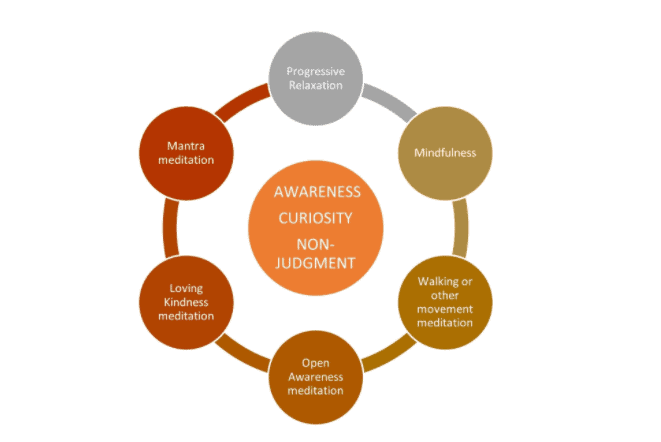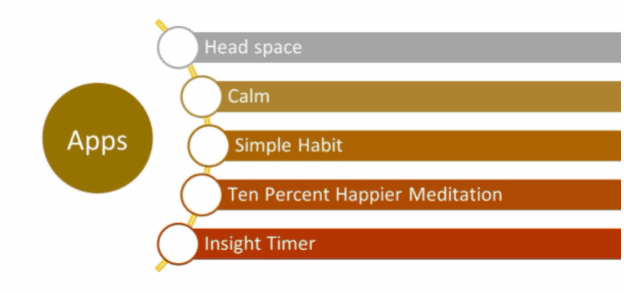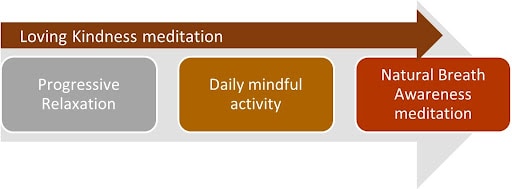
Uschi Heyd
(Senior Yoga Teacher, Bachelor of Arts in Educational Psychology, Diploma in Yogic Studies and Teacher Training)
Meditation is a number of techniques and practices which have a positive effect and benefit our physical and psychological health. These benefits are seen through reduced stress, focused attention and a higher state of awareness.
If we are a beginner, we can start with meditation in several ways, the easiest practices being Progressive Relaxation meditation (yoga nidra), Natural breath awareness meditation and Daily mindful activities.
Today we will describe these 3 types of meditation and will also go in more detail about other, more progressive, types of meditation. We will share examples and guidance on how to start and meditate.
But first, let’s answer – what is meditation?
What is Meditation?
Meditation is an enjoyable and effective process through which we broaden our perspective on life and access deeper layers of understanding about ourselves and the world around us.
Meditation teaches us how to tap into the hidden powers of the mind, and induces experiences of deep inner peace and calm. Meditation also increases our capacity to be kind and compassionate.

In meditation we turn our gaze within, something we are rarely encouraged to do in our modern culture. While we are used to processing information from our environment, we mainly remain unaware of any messages arising from within, such as bodily (somatic) sensations, emotions or intuitive insights.
Meditation helps us to be in a dynamic relationship with our inner and outer life, resulting in improved decision-making power, equanimity and peace.
For those on the spiritual path, meditation practice serves a vehicle to reach higher states of consciousness and transcendence.
Science and Research behind Meditation
Meditation has been around for thousands of years. It would be safe to say that the Yogis and Seers of old could be described as the neuroscientists of the past.
They lived extremely disciplined lives using their own mind as a laboratory to unlock the potential within. With the advancement of technology, neuroscience and neuropsychology have been able to confirm much of this ancient knowledge that has been handed down from generation to generation.
Kelly McGonical explains that “neuroscientists now know that the brain you have today is, in part, a reflection of the demands you have placed on it”.[1]
We understand today that regular meditation practice literally changes the brain structure and neural network formation, increasing our ability to concentrate, regulate emotions and be mentally more flexible.[2,3,4]
There are also numerous studies on the positive impact of meditation on a variety of health conditions, such as
- high blood pressure
- cardiovascular disease
- diabetes
- psycho-social adjustment to cancer treatment
- non-psychotic anxiety disorder, chronic pain disorder
- menstrual symptoms[5]
We will discuss more about positive impacts of meditation in our next article Health Benefits of Meditation and help with different conditions.
What are different types of meditation?
The aim of meditation is to refine and expand one’s awareness and train the mind from a dissipated state to a more organised and focused state. There are many different meditation practices to choose from that help us along the path.
The better-known practices that are suitable for beginners are:
- Loving Kindness meditation
- Mindfulness meditation
- breath awareness
- body scan
- Progressive Relaxation meditation
- Walking or other movement meditation
- Mantra meditation
- Open Awareness meditation
What kind of meditation practice you choose to start with depends on what you are most attracted to. The majority of meditation practices are done as formal practice in an upright seated position. The upright position keeps the mind alert avoiding drifting off to sleep or zoning out.
Loving-Kindness meditation
We all struggle with our ‘inner critic’, the voice within that so readily lists all the things that are wrong with us and never lets us off the hook.
In Loving Kindness meditation, we are guided in how to offer kindness to ourselves and to those we love and feel close to. Once we are comfortable with those aspects of the meditation, we expand our feelings of kindness to the wider community and even those we dislike or who annoy us.
This humble practice can have a far reaching positive impact on our emotional life.
Mindfulness meditation
A lot is written about mindfulness these days and there are many apps available to guide us in these practices.
Mindfulness is the opposite of mindlessness. Mindfulness, like other meditation practices, increases our ability to be present to experiences as they arise and encourages us to cultivate an attitude of curiosity and non-judgement.
RELATED — Introduction to Mindfulness: Enjoy the present moment and appreciate life
Body-scan and Breath Awareness meditation are two well-known mindfulness practices that are easily accessible to beginners. Mindfulness can also be practiced while engaged in daily activities such as brushing teeth, drinking a cup of tea or even breast-feeding your baby.
Progressive Relaxation meditation
Many people find it helpful to begin their meditation journey with Progressive Relaxation meditation which is done from the lying position. This practice aids the release of physical and mental tensions and trains the mind to focus inward. Turning the awareness within is the first step of meditation as described in the Yoga Sutras.
Practicing Progressive Relaxation meditation for one or two weeks to begin with will make the formal sitting practices more accessible.
However, we do recommend making this practice a regular habit as it is so easy to do and greatly benefits your physical, mental and emotional wellbeing.
RELATED — Neurofeedback therapy and brain training
Movement meditation
For those who find it difficult to sit or lie still, starting with walking meditation could be a good choice. The focus is directed on the sensations of walking, e.g. the way the feet touch the ground, the transfer of weight through each foot and so on.

Mantra meditation
Here, we focus the mind on a specific mantra by repeating this mantra mentally or aloud for a certain number of rounds or a set period of time. Most meditation mantras are recited in the Sanskrit language and are said to create specific sound vibrations that work on the mind and psyche in a positive way.
Some mantras are considered universal and suitable for everyone, others are given by one’s guru and are specifically chosen for one’s personal situation and aspiration.
Open Awareness meditation
Instead of having a chosen object to focus the awareness on, such as the breath or a mantra, here the mind is invited to roam freely. The aim is to gain awareness of the spontaneous stream of thoughts as it arises in each moment. As in all other meditation practices the inner attitude is one of curiosity and non-judgement. We learn to be the neutral observer to the thoughts arising in the field of the mind.
Here, the attention is on the awareness itself.
Why meditate?
Meditation is a tool that we can use to tap into the hidden powers of the mind.
We usually have so much noise in our head that we have little opportunity to hear the deeper wisdom that resides within. Meditation practice teaches us how to bypass the mental chatter and go beyond it so we can connect with the deeper and wiser aspects of ourselves.
Meditation transforms the mind from a disorganised state – which is full of anxieties, doubts and uncertainties – to a dynamic, peaceful and integrated state that has the potential to move mountains.
RELATED — Increase in Anxiety: Are we “The Anxious Generation”
Through regular practice, we gain a fuller understanding of who we are and the potential that lies within. We start to feel less like a leaf blown about in the wind and more like a strong tree with roots anchored deep in the earth.
This alone, however, does not make us happier or more peaceful. We also need the courage to live and act truthfully and in accordance with our values. If we have a habit of acting and behaving against our better judgement, we create tensions in the mind which will show up when we sit down for meditation.
Life is full of paradoxes and contradictions. Through meditation, we learn to hold space for all that arises. We learn that we are not “either happy or sad” but that we can make room for both.
By recognising and living with this awareness we become less bound to duality and move just that little bit closer to the experience of unity and inner freedom.
How to start and meditate today
First a few general tips on how to approach your practice.
- Please do not make meditation another chore that you have to fit into your day. Instead, make it your refuge.
- Remind yourself of the reasons why you choose to practice meditation and hold a clear vision in your mind and heart of your desired future self. Meditation can be so much more than a tool for stress relief.
- Commit to a personally chosen schedule that is doable given your current situation. Meditation requires commitment and effort but that doesn’t mean it has to be hard or difficult. Commit to a personal plan that is achievable for you, e.g. yoga nidra every second day after work or in bed before sleep, and 5 min seated breath awareness meditation every alternate day.
Sticking to the agreements you make with yourself will build trust in yourself and strengthen your willpower. So, start with setting the bar low enough so you can celebrate your achievements at the end of each week.
Meditation apps
It is exciting to see so many good meditation apps on the market these days. Many people engage with them regularly in order to relax or reset their mental and emotional frequency. Meditation apps work well for such purposes and can be a good introduction to meditation as you can use them anytime. Some examples are:

We have linked below to each app so you can choose and select which one you would like to start with.
If you want to build strong foundations from which to grow your practice and be less reliant on apps we recommend a more systematic approach to meditation. Many people benefit from joining a meditation course and having the support of a facilitator and fellow practitioners.
If you are unable to attend a course, we suggest starting with the following 3 foundation practices as a springboard to more advanced meditations.
- Progressive Relaxation meditation (yoga nidra)
- Natural breath awareness meditation
- Daily mindful activities

If you are someone who struggles emotionally, you could also add Loving-Kindness meditation to your beginner’s repertoire and practice this alongside the 3 foundation practices.
Uschi Heyd is a mind-body practitioner, mentor, facilitator and educator. She has been recognised as a senior teacher with Yoga Australia and recently co-authored ‘Yoga for Health and Wellbeing Training for prisoners in NZ’.
Uschi draws on knowledge and wisdom that she gained from 30 years of spiritual practice and academic and personal study in yoga, education, psychology & nutrition. She combines her love of yoga and psychology with her passion for education and creative expression, which can be seen in her new venture KindLiving (www.kindliving.co.nz). Uschi is based in Dunedin, NZ.
References
(1) McGonigal. (2010). Excerpt from: The Big Brain Benefits of Meditation. Retrieved from https://www.yogajournal.com/lifestyle/health/brain-meditation/
(2) Garland, E., Farb, N., Goldin, P.R., & Fredrickson, B. (2015). Mindfulness Broadens Awareness and Builds Eudaimonic Meaning: A Process Model of Mindful Positive Emotion Regulation. Psychological Inquiry, 26, 293 – 314. https://www.researchgate.net/publication/284709371_Mindfulness_Broadens_Awareness_and_Builds_Eudaimonic_Meaning_A_Process_Model_of_Mindful_Positive_Emotion_Regulation
(3) Iani, L., Lauriola, M., Chiesa, A. et al. Associations Between Mindfulness and Emotion Regulation: the Key Role of Describing and Nonreactivity. Mindfulness 10, 366–375 (2019). https://doi.org/10.1007/s12671-018-0981-5 https://www.researchgate.net/publication/325660854_Associations_Between_Mindfulness_and_Emotion_Regulation_the_Key_Role_of_Describing_and_Nonreactivity
(4) Siegel, D. (20017). The Mindful Brain. W.W. Norton and Company, Inc, New York 10110
(5) Horowitz, S. (2010). Health benefits of meditation: What the newest research shows. Alternative and Complementary Therapies, 16(4), 223-228.






